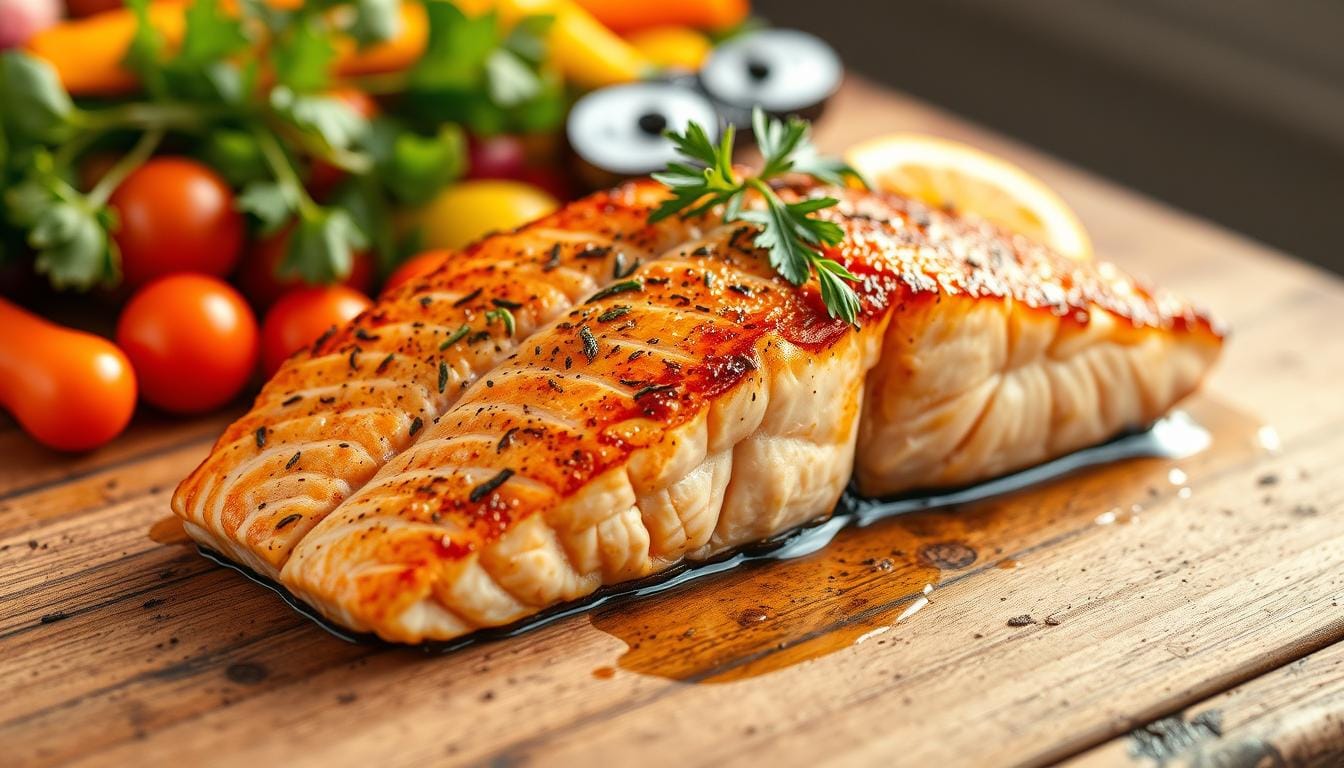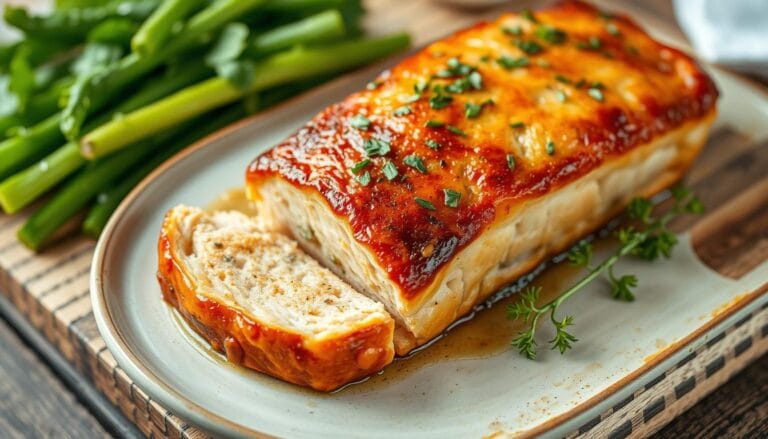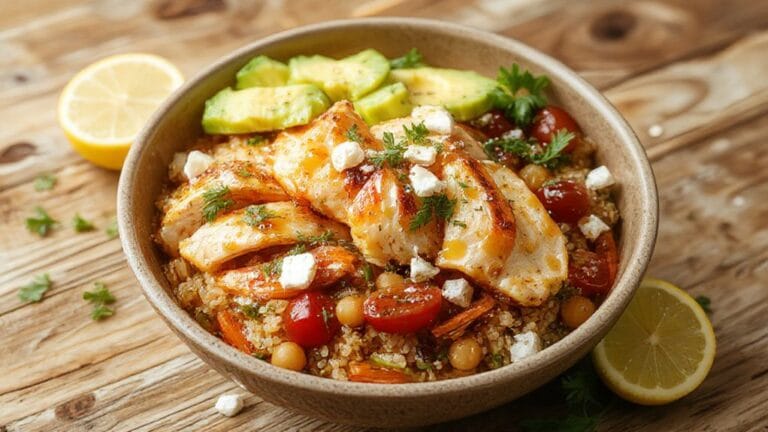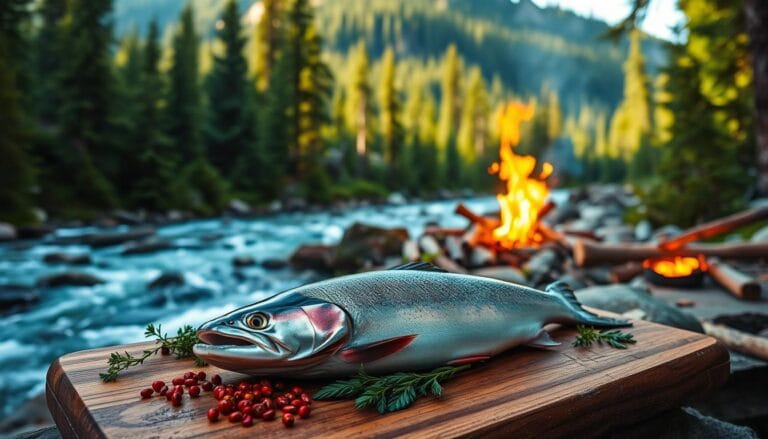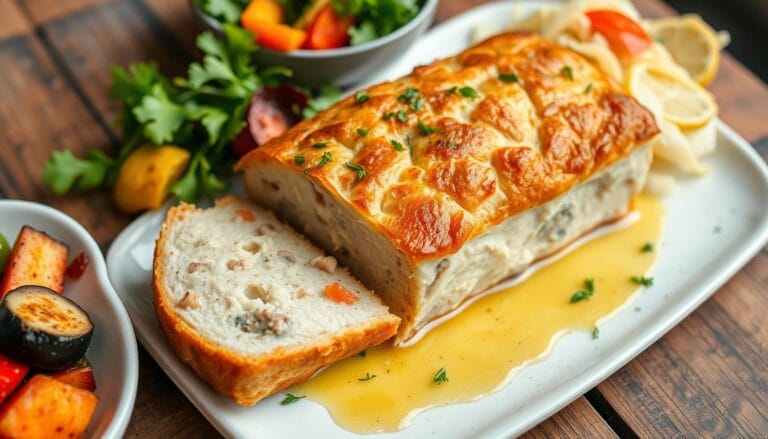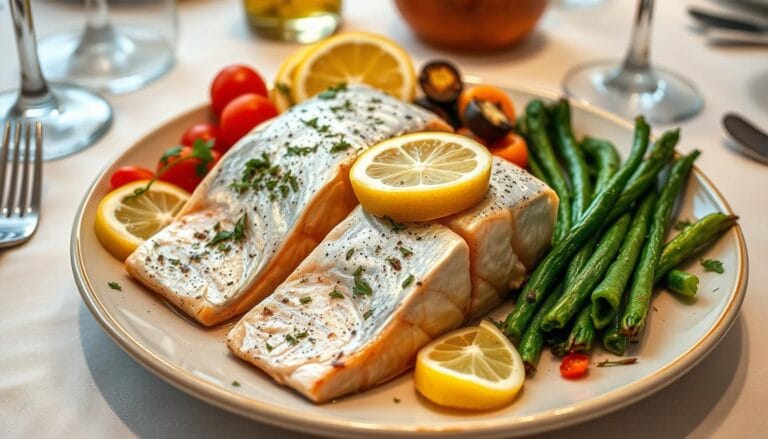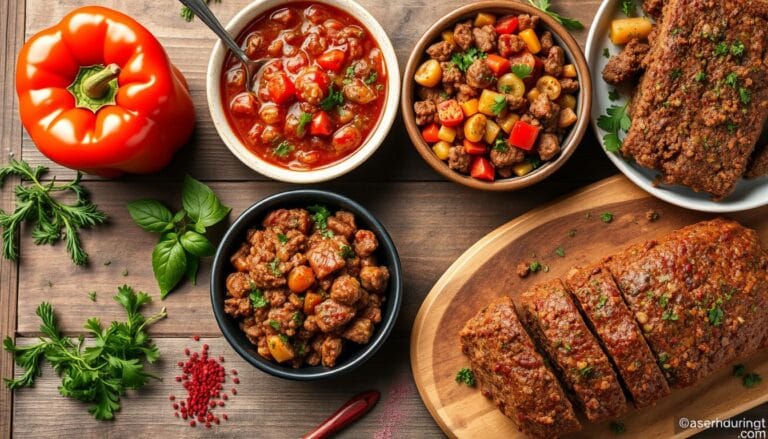Perfect Pan-Seared Salmon Steak Recipe
As the sun set, I stood in my kitchen, mesmerized by the sizzling salmon steak. The smell of sea salt, black pepper, and dried sage filled the air. It made me excited for the meal I was about to make.
This recipe is a quick and tasty way to make a fancy dish at home. It’s ready in just 15 minutes. With 6-ounce salmon steaks, it’s not only fast but also full of flavor. The mix of ingredients, including unsalted butter, makes the salmon golden and juicy inside.
Table of Contents
Understanding Salmon Steaks vs. Fillets
Choosing between salmon steaks and fillets can greatly affect your dish. Salmon steaks are cut across the spine and include the bone. This makes them thick and cross-sectional. On the other hand, fillets are cut along the spine and don’t have bones. They are often sold with or without skin.
What Makes Steaks Different
Salmon steaks have the bone in them, which brings unique benefits. They have more flesh than skin, leading to better browning and flavor. Plus, the bone-in design makes them look great, perfect for fancy seafood dishes.
Benefits of Choosing Salmon Steaks
- Increased flesh-to-skin ratio for more browning and flavor
- Impressive, restaurant-quality presentation
- Versatile for various cooking methods, including pan-searing, grilling, and baking
Anatomy of a Salmon Steak
A salmon steak has two large flesh sides, a thin skin band, and part of the spine in the middle. They come in sizes from 4 to 15 ounces. This makes them a hearty choice for any meal.
“Salmon steaks offer a unique and impressive presentation that can elevate any seafood dish to new heights.”
Whether you’re making salmon fillet recipes or exploring seafood recipes and healthy fish dishes, knowing the difference between steaks and fillets is key. It helps you pick the best option for your dishes.
Essential Ingredients for the Perfect Salmon Steak Recipe
Making the ultimate salmon steak dish starts with top-notch, fresh ingredients. You’ll need:
- Two 8-ounce salmon steaks, about 1/2 inch thick
- Sea salt and freshly ground black pepper to taste
- Dried sage for an earthy, aromatic touch
- Unsalted butter for searing and basting
For a better sear, try adding olive oil and cornstarch. Remember, the quality of the salmon matters a lot. Choose fresh, high-quality omega-3 rich foods for the best taste.
Whether you like simple salt and pepper or dried herbs like sage, the key ingredients are simple yet powerful. With the right prep and cooking, you’ll make a delicious salmon marinade that highlights the fish’s natural taste and texture.
“The key to a perfect salmon steak is using the freshest, highest-quality fish and letting the natural flavors shine through with minimal seasoning.”
The Art of Brining Salmon Steaks
Brining salmon steaks before cooking is a game-changer. It makes the fish moist and flavorful. This simple technique seasons the fish evenly and keeps juices locked in, making for a better dining experience.
Brining Time and Temperature
The brining time for salmon steaks is 15 to 30 minutes at room temperature. This short brine adds flavor without harming the fish’s delicate texture.
Salt-to-Water Ratio Guide
A basic brine ratio is 1/2 cup of kosher salt to 2 quarts of cold water. This ratio ensures your salmon steaks are perfectly seasoned, from edge to edge.
Benefits of Brining
Brining salmon steaks before cooking has several benefits. It seasons the fish evenly, boosting flavor. It also helps the salmon stay moist during cooking, making each bite juicy and tender.
While brining is optional, it greatly improves the dish. After brining, pat the salmon steaks dry. This helps get the best sear and texture when cooking.
Professional Deboning Techniques
Learning to debone salmon steaks can make your seafood dishes better. It makes eating more enjoyable. Whether you’re making easy salmon recipes or seafood recipes, knowing how to debone is key. Let’s look at how to do it right.
Start by finding the white line on top of the salmon steak. Use a sharp knife to cut along both sides of this line. Be careful around the spine and the belly flap’s membrane. Then, use kitchen scissors to remove the spine and membrane, leaving you with a clean steak.
After that, check for any pin bones. Use tweezers to pull them out carefully. Next, remove about an inch of skin from one belly flap. Roll the flap into the steak to make it neat. If needed, use toothpicks to hold it in place.
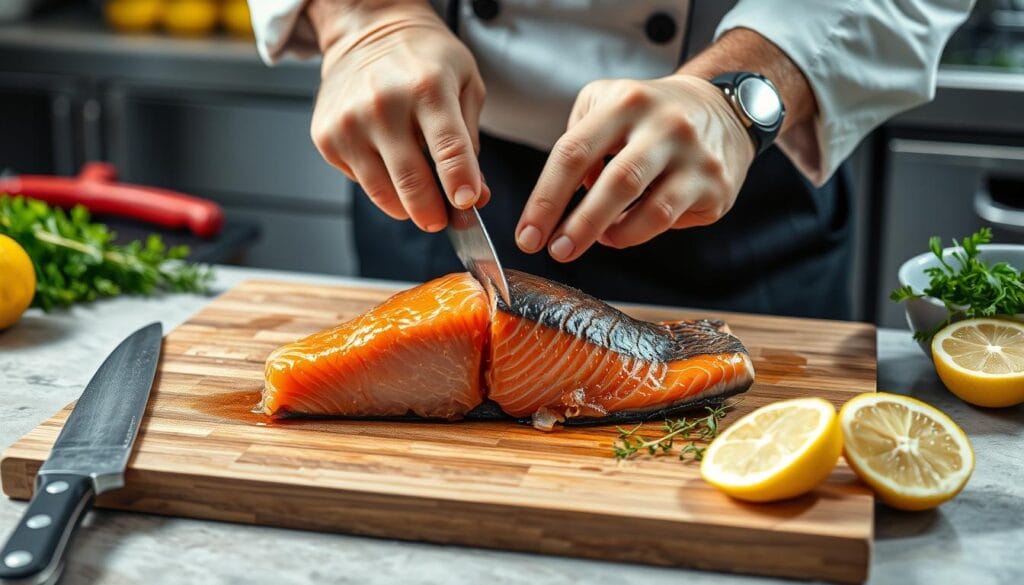
Mastering these techniques will give you a boneless salmon steak. It’s easier to cook and more fun to eat. Add your favorite seasonings and cooking methods for a great seafood meal.
Proper Seasoning and Preparation Methods
Seasoning your salmon steaks is key to bringing out their flavor. Start with salt and black pepper. Remember, salmon can handle bold flavors, but don’t be shy.
If you brined your steaks, use less salt. This prevents them from getting too salty.
Optional Seasoning Combinations
For more flavor, try adding dried herbs and spices. Sage, rosemary, or Italian seasoning can add a nice aroma. You can also use garlic powder, onion powder, or paprika for a subtle kick.
Find the seasoning mix that works best for you. It should enhance the salmon’s natural taste.
Cornstarch Coating Technique
To get a great sear, use a cornstarch coating. Spread cornstarch on a plate and coat both sides of the salmon. Then, brush off any extra.
This method gives you a crispy outside and keeps the inside juicy and flavorful. It’s perfect for pan-searing.
“Properly seasoning and preparing your salmon steaks is the secret to unlocking their full flavor potential and achieving a restaurant-quality sear.”
Essential Pan-Searing Equipment
For pan-searing salmon steaks, the right tools are key. They help get a golden crust and a tender inside. Let’s look at the must-haves for cooking the best salmon steak recipe.
A large, 12-inch nonstick or cast-iron skillet is a must. It spreads heat evenly, so the salmon doesn’t stick. You’ll also need fish spatulas or wide spatulas to flip the steaks gently.
An instant-read thermometer is also crucial. It lets you check the salmon’s doneness exactly. This ensures it’s cooked just right, whether you like it rare or well-done.
Lastly, kitchen tweezers and sharp knives are useful. Tweezers help remove bones, and knives are for deboning. Scissors can cut the spine if needed.
With these tools, you’ll be ready to pan-sear salmon steaks perfectly. Your meals will surely wow your loved ones.
Step-by-Step Pan-Searing Instructions
Learning to pan-sear salmon steaks is a fun cooking skill. Start by heating a lot of olive oil in a skillet over medium-high heat. This high heat is key for a golden-brown crust on your salmon.
Put the seasoned salmon steaks skin-side up in the hot oil. Let them sear for about 4 minutes, until the skin is golden and crisp. Don’t move the steaks during this time to get a good crust.
Cooking Times and Flipping Techniques
After the skin side is seared, flip the salmon steaks gently with a spatula. Lower the heat to medium and cook for another 4-5 minutes. Thicker steaks might need 4-5 minutes per side, with heat reduced after 3 minutes.
Visual Doneness Indicators
Watch the salmon steaks as they cook. They’ll go from translucent to opaque and flaky. This means they’re almost done. When you can flake them with a fork, they’re ready.
By following these steps, you’ll make delicious pan-seared salmon steaks at home. Enjoy your meal!
Temperature Guide for Perfect Doneness
Getting the perfect doneness for your salmon steak is key for a great meal. Whether you like it medium, medium-well, or somewhere in between, knowing the right internal temperature is essential.
For a medium to medium-well salmon steak, aim for an internal temperature of 145°F (63°C). Use an instant-read thermometer to check. This temperature makes the center flaky and moist. Remember, the salmon will cook a bit more after it’s off the heat, so keep an eye on the temperature.
If you want it more medium-rare to medium, go for 125°F (52°C). This makes the center slightly translucent, giving a tender and juicy taste. Make sure to put the thermometer in the thickest part of the steak, away from the bone, for an accurate reading.
| Doneness | Internal Temperature |
|---|---|
| Medium-Rare to Medium | 125°F (52°C) |
| Medium to Medium-Well | 145°F (63°C) |
| Well-Done | Over 151°F (66°C) |
The USDA says to cook salmon to 145°F (63°C) for safety. Try different cooking methods like pan-searing, grilling, or oven-baking to find your favorite flavor and texture.
“Perfectly cooked salmon is a delicate balance of texture and flavor. With the right temperature guide, you can create a salmon steak that will truly delight your taste buds.”
Complementary Sauce and Garnish Options
Make your salmon steak even better with tasty sauces and garnishes. You can choose from classic flavors or fresh herbs. These options will make your meal even more special. Whether you’re looking for salmon dinner ideas or easy salmon recipes, these suggestions will elevate your dish.
Classic Sauce Pairings
Try a lemon dill vinaigrette for a classic taste. It’s tangy and pairs well with the salmon’s oiliness. A vibrant chimichurri, with parsley, garlic, and red wine vinegar, is also great. For something richer, a butter sauce with lemon juice adds a luxurious touch.
Fresh Herb Combinations
Add fresh herbs to your salmon steak for extra flavor. Dill and parsley are classic choices. Chives or cilantro can add a unique twist. A squeeze of fresh lemon juice adds a refreshing finish.
| Sauce | Ingredients | Preparation Time | Review Rating |
|---|---|---|---|
| Lemon Dill Sauce | Mayonnaise, sour cream, lemon juice, dill, garlic, salt, and pepper | 10 minutes | 5 stars |
| Chimichurri | Parsley, garlic, red wine vinegar, olive oil, oregano, red pepper flakes, salt, and pepper | 15 minutes | 4.8 stars |
| Miso Sauce | Miso paste, rice vinegar, soy sauce, honey, and sesame oil | 5 minutes | 4.6 stars |
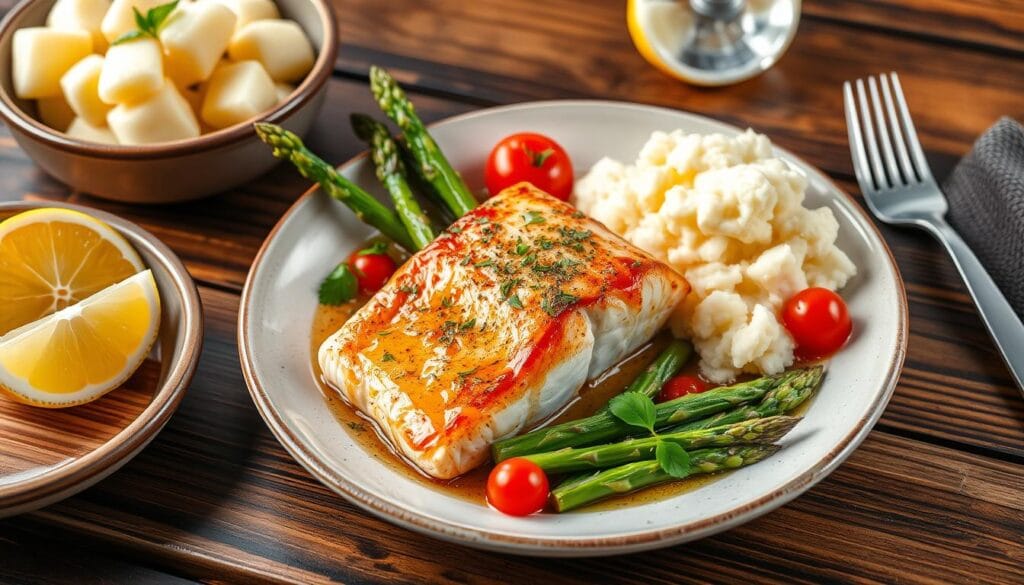
Creating a memorable salmon dish is all about trying new flavors. Experiment with different combinations to find what you like best. With creativity and quality ingredients, your salmon dinner ideas and easy salmon recipes will shine.
Side Dish Recommendations
Make your salmon dinner even better with tasty side dishes. These dishes will add flavor and variety to your meal. Whether you want healthy options or something hearty, we’ve got you covered.
Try serving your salmon with wilted spinach or roasted asparagus spears. For a fuller meal, pair it with cornbread or a light quinoa salad. You can also enjoy charred snap peas, mashed cauliflower, or a butter lettuce salad alongside your salmon.
For a more filling meal, add blackened corn or roasted vegetables to your salmon. Or, go for a classic with cornbread or a light quinoa salad.
| Side Dish | Preparation Time | Suitable for Beginners |
|---|---|---|
| Roasted Asparagus Spears | 20 minutes | Yes |
| Mashed Cauliflower | 25 minutes | Yes |
| Butter Lettuce Salad | 15 minutes | Yes |
| Blackened Corn | 30 minutes | No |
| Roasted Vegetables | 35 minutes | Yes |
| Cornbread | 40 minutes | No |
| Quinoa Salad | 25 minutes | Yes |
Adding these side dishes will make your salmon dinner complete. Try different flavors and cooking methods to enhance your meal. This way, your salmon dinner will be a hit with everyone.
Storage and Reheating Guidelines
Proper storage and reheating are key to enjoying leftover salmon steaks. Store uneaten portions in an airtight container in the fridge for up to three days. Cooked salmon can also be frozen for up to three months.
To reheat, use gentle methods to avoid drying out. The microwave is a quick option. Use 50% power and cover with a damp paper towel. You can also warm it in a skillet over medium-low heat.
Leftover salmon is great in salads or sandwiches. It’s a quick and easy meal. With the right storage and reheating, you can enjoy your salmon dinner ideas and easy salmon recipes for days.
